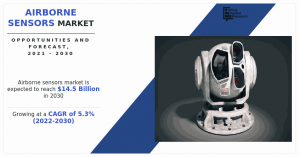USD 14.5 Billion Airborne Sensors Market Worth by 2030, CAGR of 5.3% | Industry Demand and Opportunities
Surge in threats from international terrorists & increase in defense, military budgets for consolidating the national security in developing & developed nations
WILMINGTON, DE, UNITED STATES, June 27, 2025 /EINPresswire.com/ -- Airborne sensors market size generated $9.2 billion in 2021, and is estimated to generate $14.5 billion by 2030, witnessing a CAGR of 5.3% from 2022 to 2030.The growth of the global airborne sensors market is propelled by rising international terrorism threats and increasing defense and military expenditures aimed at enhancing national security across both developed and developing nations. Furthermore, advancements in technology, continuous product innovations, and growing investments in research and development are expected to create new growth opportunities in the near future.
Download Report (228 Pages PDF with Insights, Charts, Tables, Figures) at https://www.alliedmarketresearch.com/request-sample/A16504
Extensive demand for airborne sensors in the defense sector may act as the major driving factor for the market.
An airborne sensor is a type of operator that can gather the information from airborne platforms; it can be manned or unmanned. It is mostly used for the missions such as military, public safety, academic and commercial remote sensing purposes. In defense sector, airborne sensors support surveillance, intelligence, and reconnaissance collection operations. Also, it can be used in Combat Search & Rescue (CSAR) and tactical combat operations. Moreover, signal intelligence plays vital role in government and defence authorities. Moreover, combination of signal intelligence and airborne sensor helps in detecting, identifying, locating, and tracking the full-time spectrum awareness and intelligence to national as well as a tactical user.
The airborne sensor industry will be witnessing a massive growth mainly because of the increase in adoption of airborne sensors in the defense sector. Airborne sensors can support surveillance, intelligence, and reconnaissance collection operations in military missions.
Buy This Research Report: https://www.alliedmarketresearch.com/airborne-sensors-market/purchase-options
The global airborne sensors market is segmented on the basis of type, application, and region. By type, the market has been divided into non-scanning and scanning airborne sensors. By application, the analysis has been divided into defense aircraft, commercial aircraft, and others. By region, the market is analysed across North America, Europe, Asia-Pacific, and LAMEA.
Based on region, North America accounted for the highest market share in terms of revenue in 2021, holding more than one-fourth of the global airborne sensors industry, and is expected to maintain its dominance in terms of revenue by 2030. This is due to rise in public spending on imaging software and integration of smart sensing technologies by leading tech companies such as Uber and Tesla for development of self-driving cars. However, Asia-Pacific is estimated to register the fastest CAGR of 5.9% during the forecast period, owing to surge in demand for improved technologies in radars, electro-optics/infrared (EO/IR) sensors, and others. In addition, the development of next-generation aircrafts and increase in defense contracts supplement the market growth.
For Purchase Enquiry: https://www.alliedmarketresearch.com/purchase-enquiry/A16504
Leading Market Players
Hexagon
Thales Group
Raytheon Technologies
Lockheed Martin Corporation
information systems laboratories
teledyne optech
General Dynamics Corporation
Honeywell International Inc.
ITT Inc.
AVT Airborne Sensing GmbH
Trending Reports:
Ultralight Aircraft Market: https://www.alliedmarketresearch.com/ultralight-aircraft-market
Unmanned Aerial Vehicles (UAVs) Simulation Market: https://www.alliedmarketresearch.com/unmanned-aerial-vehicles-uavs-simulation-market-A08545
Aircraft Window Frame Market: https://www.alliedmarketresearch.com/aircraft-window-frame-market-A31492
David Correa
Allied Market Research
+ 1800-792-5285
email us here
Visit us on social media:
LinkedIn
Facebook
YouTube
X
Legal Disclaimer:
EIN Presswire provides this news content "as is" without warranty of any kind. We do not accept any responsibility or liability for the accuracy, content, images, videos, licenses, completeness, legality, or reliability of the information contained in this article. If you have any complaints or copyright issues related to this article, kindly contact the author above.
The Aku Venue Event Center, LLC Earns 2025 Best of South Carolina Award for Excellence in Event Hosting and Planning
Pre-Orders Opened on July 18 for 'Guts Berserker Armor ‘Rage’' Plastic Model Kit
A Voice of Light: Viviana Puello’s Journey Through Music, Film, and Soul
Kalendarium
Więcej ważnych informacji
 Jedynka Newserii
Jedynka Newserii

 Jedynka Newserii
Jedynka Newserii

Prawo

KE proponuje nowy Fundusz Konkurencyjności. Ma pobudzić inwestycje w strategiczne dla Europy technologie
W środę 16 lipca Komisja Europejska przedstawiła projekt budżetu na lata 2028–2034. Jedna z propozycji zakłada utworzenie Europejskiego Funduszu Konkurencyjności o wartości ponad 400 mld euro, który ma pobudzić inwestycje w technologie strategiczne dla jednolitego rynku. Wśród wspieranych obszarów znalazła się obronność i przestrzeń kosmiczna. Na ten cel ma trafić ponad 130 mld euro, pięciokrotnie więcej niż do tej pory.
Firma
Były prezes PGE: OZE potrzebuje wsparcia magazynów energii. To temat traktowany po macoszemu

Choć udział odnawialnych źródeł energii w miksie energetycznym Polski jest stosunkowo wysoki i rośnie, to ten przyrost jest chaotyczny i nierównomiernie rozłożony miedzy technologiami – wskazuje Forum Energii. Dodatkowo OZE potrzebują wsparcia magazynów energii, a zdaniem Wojciecha Dąbrowskiego, prezesa Fundacji SET, ten temat jest traktowany po macoszemu. Brak magazynów powoduje, że produkcja energii z OZE jest tymczasowo wyłączana, co oznacza marnowanie potencjału tych źródeł.
Infrastruktura
Wzrost wynagrodzeń ekip budowlanych najmocniej wpływa na koszty budowy domu. Zainteresowanie inwestorów mimo to nieznacznie wzrasta

Budowa metra kwadratowego domu w Polsce kosztuje od 5,55 do 6 tys. zł w zależności od województwa – wynika z najnowszych analiz firmy Sekocenbud. Najdrożej jest w Warszawie, gdzie cena za metr kwadratowy domu przekroczyła już 6,2 tys. zł. Na przyrosty kosztów budowy domu wpływają zarówno drożejące materiały budowlane, jak i wyższe wynagrodzenia pracowników. Inwestorzy nie rezygnują jednak z budowy domów jednorodzinnych, co ma związek m.in. z wciąż wysokimi cenami mieszkań czy też obniżką stóp procentowych.
Partner serwisu
Szkolenia

Akademia Newserii
Akademia Newserii to projekt, w ramach którego najlepsi polscy dziennikarze biznesowi, giełdowi oraz lifestylowi, a także szkoleniowcy z wieloletnim doświadczeniem dzielą się swoją wiedzą nt. pracy z mediami.









.gif)

 |
| |
| |
|